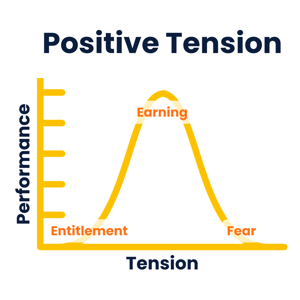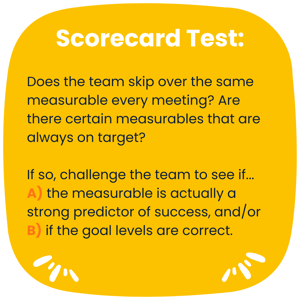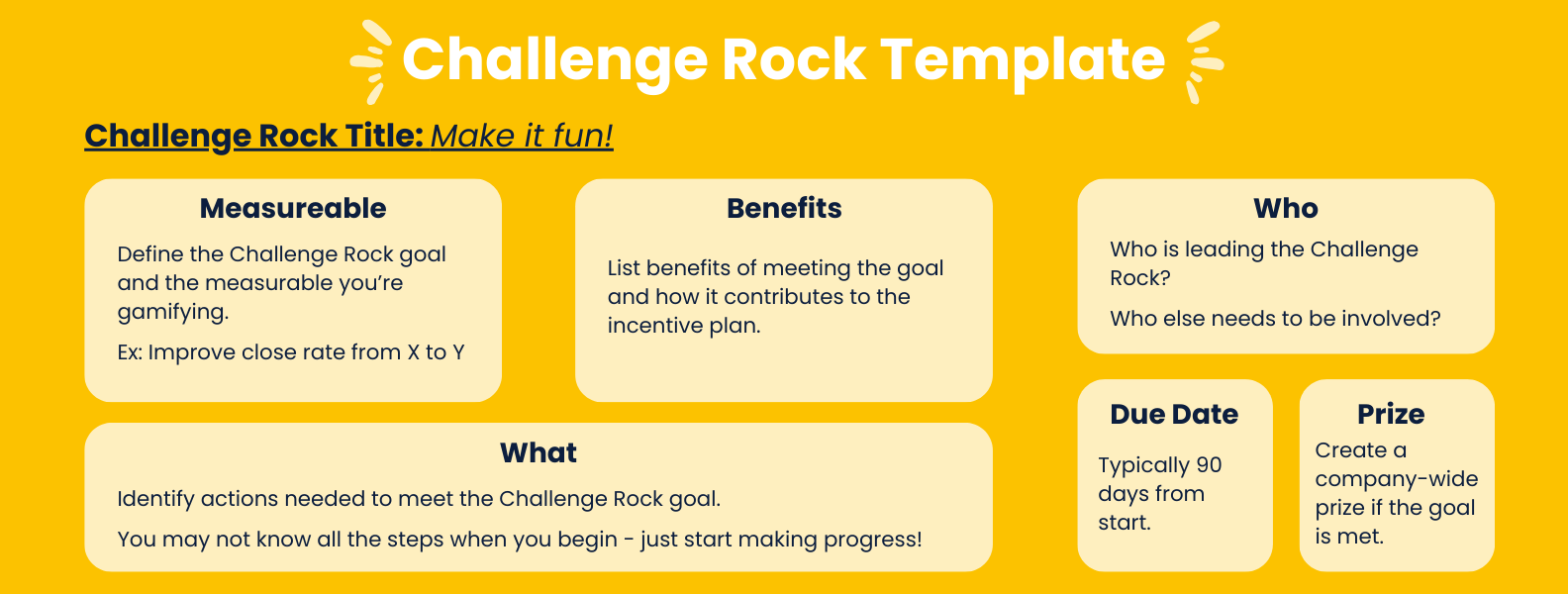Measure What Matters: Using Scorecards to Create Positive Tension

How do you ensure that everyone is on the same page when it comes to setting and meeting goals? Scorecards might not be a new concept to many companies within the Small Giants Community, who may use them to aid with accountability and metrics. But the team from ProfitWorks is sharing their particular approach to scorecards, namely how they can create positive tension, which in turn leads to a successful culture and outcome.
Maintaining a culture that fosters transparency and education is paramount to the success of these scorecards. Without a healthy level of transparency, and the time taken to educate employees, the measurements on scorecards can lack meaning, and therefore feel less impactful.
Ultimately, the scorecard should be telling a story. It should say what your purpose is, and how you aim to fulfill that purpose through your goals. As long as everyone on the team aligns with the company’s values, these tools can be implemented in a fluid and effective manner.
So, with the spirit of transparency and education in mind, let’s dive into how to create these scorecards, and how they can help to build positive tension.
What is Positive Tension?
First, let’s define the type of tension that we’re aiming for to encourage profitability and team cohesion. While tension is often thought of as having a negative connotation, a certain amount – and kind – of tension can be healthy.
Positive tension is when there is a force stretching us for our own benefit, and pulling us in a focused, primary direction. This kind of tension fosters motivation among employees, challenging them enough to push their limits, without going so far as to be discouraging.
The ProfitWorks team uses the Yerkes-Dodson Natural Law Curve to illustrate how tension aids in the profitability and success of a business, as illustrated below:

Not enough education and tension can make employees feel entitled to something that might not even be available to them, or feel a lack of connection to the mission. At the same time, too much tension can be overwhelming and cause fear. Just the right amount leads to high performance and a communal feeling of success.
Using this law as a lens can help companies utilize a wide variety of tools to add and maintain positive tension in their organization – all, ultimately, designed to improve company performance.
It’s important to keep in mind, though, that tension remains positive only as long as it is balanced with structure and support, and integrated more holistically into the company’s structure. Without clear communication and helpful tools, the tension can become misguided and unhealthy.
Some examples of positive tension tools are:
- A core values document used to determine hiring + firing decisions
- Company-wide vision plans
- Accountability charts
- Disciplined meeting structures
- Incentive plans
- Scorecards
Let’s dig into that last bullet and see how ProfitWorks utilizes this tool to build positive tension and measure impact among teams.
How to Create an Effective Scorecard
Not all scorecards are created equal, and it’s important that these tools are crafted and implemented with intentionality. Each company’s (or team’s) scorecard may look a bit different in order for it to best serve its people and purpose.
- The first step in creating an effective scorecard is determining the right measurables. These measurables should be as specific as possible, and the goals of each should push the team to perform at their best. Not sure if something will make a useful measurable? Here’s one way to think of it: it’s easiest to measure a goal that can be clearly tied to driving company profit. (For additional details on selecting metrics, see next section.)
- Next, decide on a timeline or cadence for your scorecard. The ProfitWorks team suggests using a 13 week cycle. As they’ve observed, 13 weeks, or about each quarter, is the appropriate amount of time to be able to observe trends and generate fruitful discussions from them. However, use whatever cadence suits your team best.
- Then, assign an owner to each measurable - someone who is responsible for determining and tracking the metric. This should be someone whose job responsibilities are naturally tied to the metric, be it because of their job description, or their day-to-day tasks. Remember, ownership is a form of accountability, which builds positive tension.
- Finally, use the scorecard! Incorporate it into your weekly team meetings, and have the owner of each measurable report on their progress. This is meant to be a tool to help teams be proactive in identifying, addressing, and solving issues. It should help a team strengthen their ability to predict outcomes, and therefore build trust through more consistent expectations.

Remember that you may have to tweak a scorecard after using it for a while. It may become clear that you’re not measuring the right things, or the ownership is not attributed to the most appropriate person. It’s better to adjust as needed than stick with an ineffective tool.
Reviewing Your Current Scorecard
Maybe your team already has an active scorecard, but it doesn’t seem to be doing the trick. It could be that your vision and goals have changed, but you haven’t adjusted the metrics to reflect that. Or, you’ve used the same measurables for so long, your team can complete those tasks and meet the goals in their sleep, and therefore the numbers aren’t propelling you forward.
If you have a scorecard, now, at the beginning of the year, is the perfect time to reevaluate if and how this tool is serving you.
.png?width=1584&height=600&name=Challenge%20Rock%20Template%20-%20ProfitWorks%20(1).png)
Presumably, you and your team took the time at the end of last year, or beginning of this year, to consider your goals and areas of focus for the months ahead. Look at those goals alongside your scorecard. Are the measurables relevant in tracking the progress of these goals? The owner of the metric, with the help of their manager, should be responsible in determining its effectiveness.
It’s also important to consider the “why” behind every metric. What is the story you’re trying to tell with any particular measurable? Maybe, for example, you’re tracking retention rates to understand how effective your new training program is. Or perhaps you’re measuring sales rates throughout the year to determine your most profitable season, which in turn allows you to budget accordingly. Whatever the scope of the measurable, it should address either an opportunity or a challenge, who should be involved, and what steps need to be taken to meet expectations or solve the issue at hand.
If a scorecard metric isn’t pointing at leading indicators, directing you towards a specific goal, or addressing a challenge, it needs to be tweaked until it does so, or questioned if it’s worth keeping.
Cascade Scorecards Through the Organization
While it might make the most sense to attribute your first scorecard to the leadership team, this tool doesn’t have to (and shouldn’t!) remain at the top. Each department can also have their own scorecards that track specific and predictive determinants of their team’s success. This then ties back to how they’re impacting the company’s overall performance.
By having specific scorecards for each team or department, you’re ensuring that the measurables can be specific and relevant to everyone. The leadership team may have a goal of successfully launching a new product or service, and then everyone’s scorecards reflect their role in reaching that goal (ie the marketing team may measure performance statistics of a social media campaign announcing the new product).
Having scorecards across departments also ensures that each department is sharing a common language and being held accountable to the same standard, thus building the right amount of positive tension. The long-term goal is that everyone in the organization is tied to a weekly number so they all feel connected to this common language and the company purpose.
When executed well, scorecards create increased accountability, which in turn drives increased productivity, employee engagement, and ultimately, company success.
Tools to Link Measurables to an Incentive Plan
Even if you don’t have an employee ownership structure, the use of scorecards to track performance and profitability can help employees feel more closely tied to the organization’s success, and ultimately to the success of their incentive plan, which can support positive tension individually and collectively. ProfitWorks doesn’t recommend tying incentive payment directly to individual scorecard measurables. Rather, they suggest creating an incentive plan based on surpassing a threshold of company profit (the true score at the end of the game!). Through business literacy workshops they train teams to ensure that the scorecard measurables better link to day-to-day activities and to driving overall incremental profit improvement. Creating incentive plans around the scorecard can be another step in helping motivate and contextualize employees.
A unique method ProfitWorks suggests to create a stronger link between activities and profit improvement is through using a tension tool called a Challenge Rock. A Challenge Rock is a fun 90 day priority that is gamified in order to help surpass a target. Turning a measurable goal into a Challenge Rock creates a spirit of focus, attention, teamwork, and a company-wide celebration when the goal is achieved.
In order to make sure everyone is clear about the Challenge Rock, present it through a well-defined outline, such as the one below, stating the goals, stakeholders, and reward if the outcome is met.

Recognize the cultural benefits along with the business benefits when deploying Challenge Rocks and make them a fun and educational event. One company that ProfitWorks worked with related several Challenge Rocks to movie themes, and used modified promotional posters and costumed presentations to get everyone laughing and engaged.

In Conclusion
Well-designed and properly implemented scorecards create positive tension by developing clear communication and accountability throughout the organization. Used this way, scorecards can also help hone in on your culture, and determine who is aligned with your values by seeing who engages well with the scorecard.
Measuring key business metrics consistently and with educational language ensures that goals don’t stray off target, and also helps to avoid miscommunications or unhealthy tension among the team. By making goals clear, consistent, and clearly tied to company success, your employees will stay engaged with each other and their own role in the company’s overall success.
If you’d like to learn more about ProfitWorks, including the launch of their new book, “Stretch Not Snap”, as well as free downloadable tools and resources, visit their website.





Submit Your Comment